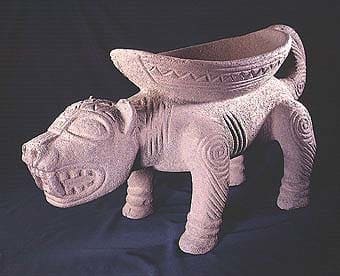Basalt Sculpture of a Jaguar with a Bowl on its Back, 500 CE - 1000 CE
Basalt
16.5 x 30
PF.4594
The discovery of metates and mortars in burial chambers marked the beginning of exciting new insights into the social structure of the Ancient Costa Ricans. It is known they served...
The discovery of metates and mortars in burial chambers marked the beginning of exciting new insights into the social structure of the Ancient Costa Ricans. It is known they served as utilitarian objects for grinding corn and earth pigments, but also as ceremonial sculptures with symbolic meaning. Found in elite tombs it is speculated that the production and distribution of ceremonial mortars was a way of visually demonstrating the ruling classes' control of food, land and labor, warfare and continued land acquisition. As a subtle and refined form of propaganda the mortar would instantly be associated with the process for making food and with the people who made it possible to have the raw materials. Considering their importance, it is not surprising that the finest stone sculptors were employed to create remarkable objects such as this very beautiful, powerful and unique mortar. The jaguar was feared and respected in the wild and as a mythical figure it represented the night sun in the underworld. Here he is carved with exquisite detail in lovely geometric designs on his legs and tail in the form of twirling circles and curves. On the back of his head there is a band with a diamond and X pattern closely resembling a real jaguar's markings. This noble animal is both master of the jungle and the Underworld, seen here in the latter role carrying the earth-bowl on his back. The person using the bowl to grind corn would have been reminded of where the food came from, who made it possible to be grown and harvested, and the gods who were the life force. Such an object with so much intensity of purpose, retained in an elegant form after so many centuries without loosing any of its power, is truly a superb work of art.
Literature
V24
